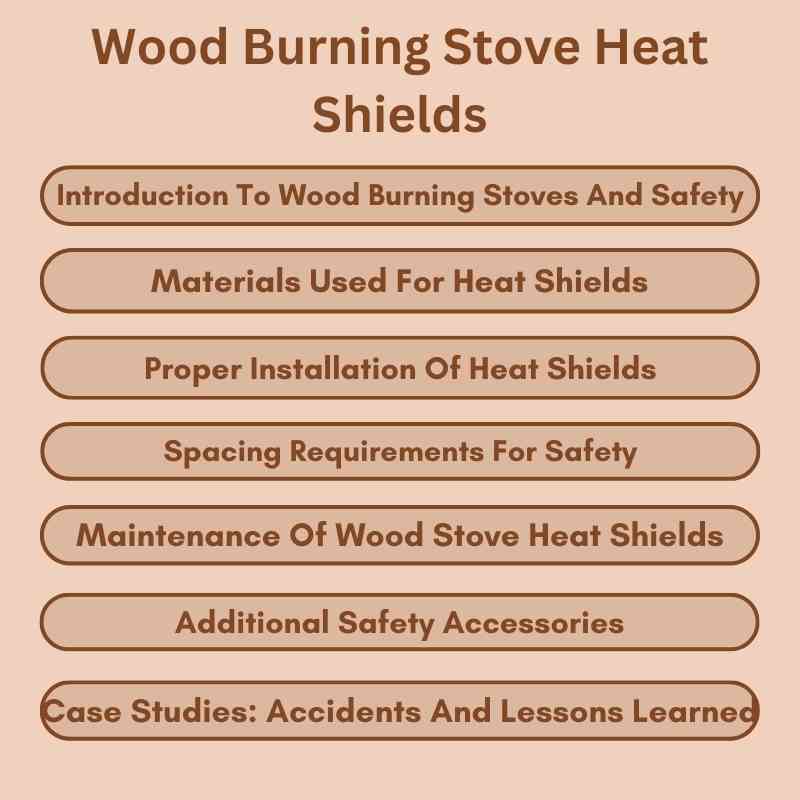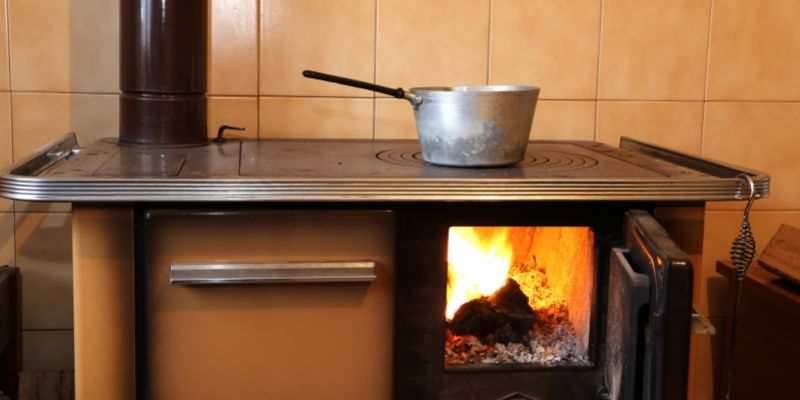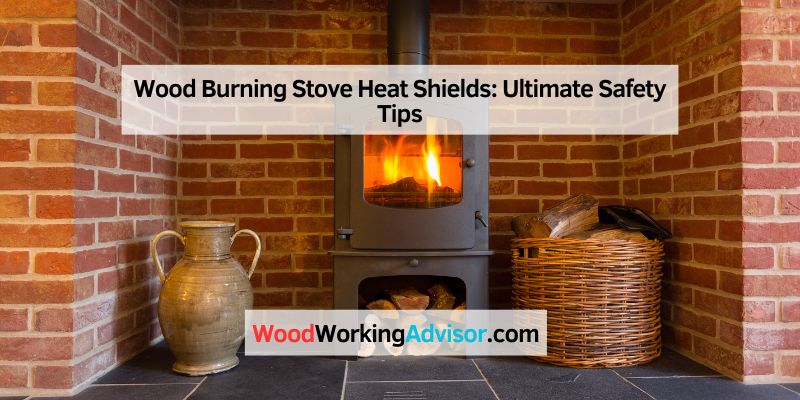Wood burning stove heat shields protect walls from excessive heat and improve efficiency. They reduce the risk of fire hazards while enhancing comfort.
Heat shields are essential for wood burning stoves, especially in smaller spaces. They create a safer environment by preventing heat damage to nearby surfaces. Proper installation and materials can significantly increase your stove’s efficiency. By reflecting heat back into the room, they help maintain a cozy atmosphere during colder months.
Available in various designs and materials, these shields can complement any décor. Understanding their importance will help you make informed decisions for your home. Investing in a quality heat shield not only ensures safety but also optimizes the performance of your wood burning stove, providing warmth and comfort efficiently.
Introduction To Wood Burning Stoves And Safety
Wood burning stoves provide warmth and charm to homes. They have become popular for heating and cooking. However, safety is crucial. Understanding wood stoves helps ensure a safe environment.
Rising Popularity Of Wood Stoves
Many people are turning to wood burning stoves for several reasons:
- Eco-friendly: They use renewable resources.
- Cost-effective: Wood can be cheaper than other fuels.
- Efficient heating: They provide excellent warmth.
- Ambiance: A wood stove creates a cozy atmosphere.
As the demand grows, so does the need for safety measures. Proper installation and maintenance are key.
Importance Of Safety Measures
Wood burning stoves can be safe with the right precautions. Here are some essential safety measures:
- Install a heat shield. It protects walls from heat damage.
- Keep flammable materials away from the stove.
- Use seasoned wood. It burns cleaner and reduces creosote.
- Regularly clean the chimney. This prevents chimney fires.
- Install smoke and carbon monoxide detectors.
Understanding these safety measures helps reduce risks. Enjoying a warm home should never come at the cost of safety.
| Safety Measure | Description |
|---|---|
| Heat Shield | Prevents heat damage to walls. |
| Flammable Materials | Keep them at least 3 feet away. |
| Seasoned Wood | Burns cleaner, produces less smoke. |
| Chimney Cleaning | Reduces risk of chimney fires. |
| Detectors | Alert for smoke and carbon monoxide. |
These steps ensure a safe and enjoyable experience with wood burning stoves.

Materials Used For Heat Shields
Heat shields protect your home from the intense heat of wood burning stoves. They prevent fire hazards and enhance efficiency. Choosing the right material is crucial for safety and performance.
Common Heat Shield Materials
- Metal
- Ceramic
- Brick
- Concrete
- Glass
Pros And Cons Of Different Materials
| Material | Pros | Cons |
|---|---|---|
| Metal |
|
|
| Ceramic |
|
|
| Brick |
|
|
| Concrete |
|
|
| Glass |
|
|
Proper Installation Of Heat Shields
Installing heat shields for your wood burning stove is crucial. They protect your walls and floors from heat damage. Proper installation ensures safety and efficiency. Follow these steps for a successful setup.
Step-by-step Guide
- Gather Materials: Collect heat shield, brackets, screws, and tools.
- Measure Area: Measure the space around the stove.
- Prepare Wall: Clean the wall surface for better adhesion.
- Mark Locations: Use a pencil to mark where brackets will go.
- Install Brackets: Secure brackets to the wall using screws.
- Attach Heat Shield: Hang the heat shield on the brackets.
- Check Level: Use a level to ensure the shield is straight.
- Secure with Screws: Tighten screws to hold the heat shield in place.
Professional Vs. DIY Installation
| Installation Type | Pros | Cons |
|---|---|---|
| Professional Installation |
|
|
| DIY Installation |
|
|
Regulatory Compliance And Standards
Understanding regulatory compliance and standards is crucial for wood burning stoves. These regulations ensure safety and efficiency in heating systems. Compliance protects homes and enhances performance.
Local Building Codes
Local building codes vary by region. They set rules for installation and use of wood burning stoves. Homeowners must follow these codes to ensure safety.
- Check local regulations before installation.
- Building codes may require specific clearances.
- Permits may be necessary for installation.
Local authorities often provide resources. Contact them for guidance on compliance.
National Fire Protection Standards
The National Fire Protection Association (NFPA) offers essential guidelines. These standards promote safety for wood burning appliances.
| Standard | Description |
|---|---|
| NFPA 211 | Standard for Chimneys, Fireplaces, Vents, and Solid Fuel-Burning Appliances |
| NFPA 70 | National Electrical Code for electrical safety |
| NFPA 303 | Standards for Marina Fire Protection |
Following NFPA standards ensures safe operation. Homeowners should regularly check for updates. Compliance helps prevent fire hazards.
Spacing Requirements For Safety
Proper spacing is crucial for the safe operation of wood burning stoves. Heat shields help protect nearby surfaces from high temperatures. Understanding the spacing requirements minimizes fire risks. Always prioritize safety when installing your stove.
Minimum Distance From Combustibles
Knowing the minimum distance from combustibles is essential. Follow these guidelines:
- Wood: At least 36 inches.
- Paper: At least 48 inches.
- Plastic: At least 48 inches.
These distances help prevent heat damage. Always check local building codes. They may have specific requirements.
Calculating Safe Clearances
Calculating safe clearances involves a few steps. Follow this simple guide:
- Measure the distance from the stove to walls.
- Use a level to check the stove’s height.
- Account for heat shield dimensions.
- Adjust measurements based on local regulations.
Here’s a quick reference table for clearances:
| Material | Minimum Clearance (inches) |
|---|---|
| Wood | 36 |
| Drywall | 24 |
| Brick | 12 |
Always maintain these clearances. Safety is key to enjoying your wood burning stove.
Maintenance Of Wood Stove Heat Shields
Proper maintenance of wood stove heat shields keeps them effective and safe. Regular care prevents damage and ensures optimal performance. Follow these tips for a thorough maintenance routine.
Routine Inspection Tips
- Check for rust or corrosion.
- Look for cracks or dents.
- Inspect the seams and edges.
- Ensure proper installation and fit.
- Examine the heat shield’s attachment points.
Schedule inspections at least twice a year. Inspect before the heating season begins and after it ends. This helps catch problems early.
Cleaning And Upkeep
Regular cleaning maintains the effectiveness of heat shields. Use the following methods:
- Use a soft brush to remove dust.
- Wipe with a damp cloth for stubborn stains.
- Avoid harsh chemicals that may damage the surface.
- Check for any buildup of creosote.
For deeper cleaning, consider using:
| Cleaning Method | Description |
|---|---|
| Soap and Water | Mix mild soap with water. Use a soft cloth. |
| Vinegar Solution | Mix equal parts of vinegar and water. Spray and wipe. |
| Commercial Cleaner | Use a product specifically for metal surfaces. |
Always allow heat shields to dry completely after cleaning. This prevents rust and prolongs their lifespan.
Additional Safety Accessories
Using a wood burning stove can create a cozy atmosphere. However, safety should always be a priority. Several accessories can enhance your safety. These include floor protectors, stove gloves, and thermometers. Each accessory plays a vital role in preventing accidents.
Using Floor Protectors
Floor protectors serve as a barrier against heat and sparks. They shield your floor from burns and damage. Here are some key points about floor protectors:
- Material: Look for non-combustible materials.
- Size: Ensure it covers the entire area under the stove.
- Design: Choose a design that matches your home decor.
Benefits of floor protectors:
| Benefit | Description |
|---|---|
| Fire Safety | Reduces fire hazards from embers. |
| Damage Prevention | Protects your flooring from heat damage. |
| Ease of Cleaning | Makes cleaning easier and more efficient. |
Benefits Of Stove Gloves And Thermometers
Stove gloves protect your hands from burns. They allow you to handle hot materials safely. Look for gloves made from heat-resistant materials.
Thermometers ensure your stove operates at the right temperature. They help maintain efficiency and safety. Here are some benefits:
- Safety: Prevents overheating.
- Efficiency: Improves fuel usage.
- Convenience: Easy to read and use.
Using gloves and thermometers creates a safer environment. Always keep them within reach when using your stove.
Case Studies: Accidents And Lessons Learned
Understanding real-life incidents helps improve safety with wood burning stoves. Learning from past mistakes can prevent future accidents. Here, we explore some significant case studies and their implications.
Real-life Incidents
Several accidents involving wood burning stoves have occurred over the years. Each incident teaches us valuable lessons. Here are a few notable examples:
- Incident 1: A family lost their home to a fire. A poorly installed heat shield failed to protect the walls.
- Incident 2: A homeowner suffered burns. The stove was too close to combustible materials.
- Incident 3: Smoke inhalation occurred. The flue was blocked, causing dangerous fumes indoors.
| Incident | Cause | Outcome |
|---|---|---|
| Fire in Home | Poor installation | Complete loss |
| Burn Injury | Proximity to combustibles | Severe burns |
| Smoke Inhalation | Blocked flue | Hospital treatment |
Best Practices Derived From Past Mistakes
Learning from these incidents helps improve safety measures. Here are some best practices to follow:
- Install Heat Shields Properly: Ensure correct installation according to manufacturer guidelines.
- Maintain Distance: Keep combustible materials at least three feet away from the stove.
- Regular Inspections: Check the flue and chimney regularly for blockages.
- Use Quality Materials: Invest in high-quality heat shields designed for your stove.
Implementing these practices can significantly reduce risks. Always prioritize safety with wood burning stoves.
Conclusion: Cultivating Safe Heating Practices
Safe heating is essential for every home. Wood burning stoves provide warmth, but they need care. Heat shields play a vital role in safety. They protect walls and nearby objects from high temperatures.
Encouraging Vigilance And Responsibility
Using a wood burning stove requires attention and caution. Here are some key practices:
- Regular Maintenance: Clean the stove and chimney frequently.
- Monitor Temperature: Use a thermometer to avoid overheating.
- Install Heat Shields: Use them to protect your walls.
- Keep Combustibles Away: Maintain a safe distance from flammable items.
- Educate Family Members: Ensure everyone knows how to use the stove safely.
These steps help prevent accidents. Awareness leads to better safety practices.
Further Resources And Expert Advice
For more information on safe heating, consider these resources:
| Resource Type | Description | Link |
|---|---|---|
| Government Guidelines | Official safety recommendations for wood stoves. | Visit Here |
| Local Fire Department | Advice on safe heating practices. | Visit Here |
| Expert Blogs | Tips from professionals in the field. | Visit Here |
Stay informed. Use these resources to enhance your knowledge. Safe heating is everyone’s responsibility.

Frequently Asked Questions
What Are Wood Burning Stove Heat Shields?
Wood burning stove heat shields are protective barriers that reduce heat transfer. They help prevent heat damage to walls and furniture. By reflecting heat back into the room, they enhance efficiency. Proper installation can improve safety and extend the lifespan of your stove.
Do Heat Shields Improve Wood Stove Efficiency?
Yes, heat shields significantly improve wood stove efficiency. They reflect heat back into the room, maximizing warmth. This reduces the need for additional heating sources. Consequently, you save on fuel costs and create a more comfortable living environment.
How To Install A Heat Shield For A Wood Stove?
Installing a heat shield requires careful planning. First, measure the area around the stove. Next, mount the shield at the recommended distance from the stove. Use appropriate materials to ensure safety and durability. Always follow manufacturer guidelines for best results.
Are Heat Shields Required For Wood Stoves?
Heat shields are not always required, but they are highly recommended. They protect surrounding surfaces from excessive heat. Additionally, they enhance the stove’s performance. Always check local regulations and manufacturer guidelines to determine necessity.
Conclusion
Choosing the right heat shield for your wood burning stove is essential for safety and efficiency. These shields protect your home from excessive heat while enhancing your stove’s performance. Investing in a quality heat shield ensures a cozy environment. Prioritize safety and comfort for a better heating experience this winter.

